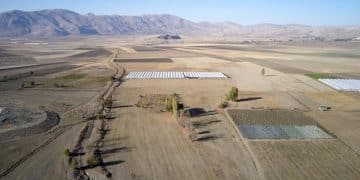Federal Carbon Pricing & Renewable Energy: A US Policy Analysis

The Impact of the Federal Carbon Pricing Debate on Renewable Energy Adoption Rates: A Policy Analysis examines how discussions around carbon pricing policies at the federal level in the US influence the speed at which renewable energy sources are adopted and integrated into the nation’s energy infrastructure.
The ongoing debate surrounding federal carbon pricing in the United States has significant implications for the adoption of renewable energy sources. Understanding the impact of the federal carbon pricing debate on renewable energy adoption rates: a policy analysis is crucial for shaping effective energy policies and achieving a sustainable energy future.
Understanding Federal Carbon Pricing Mechanisms
Federal carbon pricing mechanisms are designed to internalize the cost of carbon emissions, making polluting activities more expensive and incentivizing cleaner alternatives. These mechanisms play a pivotal role in shaping the energy landscape and influencing the adoption of renewable energy technologies.
Types of Carbon Pricing Mechanisms
Several approaches exist for implementing carbon pricing, each with its own set of advantages and challenges. These include carbon taxes and cap-and-trade systems.
- Carbon Tax: A carbon tax directly levies a fee on each ton of carbon dioxide or equivalent greenhouse gas emitted.
- Cap-and-Trade: This system sets a limit (cap) on total emissions and allows companies to buy and sell emission allowances (trade).
- Hybrid Systems: Some policies combine elements of both carbon taxes and cap-and-trade systems to achieve desired outcomes.

The choice of carbon pricing mechanism can significantly influence its effectiveness in driving renewable energy adoption. Each approach has its own strengths and weaknesses that must be carefully considered.
The Current Landscape of Renewable Energy Adoption in the US
The United States has witnessed a notable increase in renewable energy adoption over the past decade, driven by technological advancements, declining costs, and supportive policies. Understanding the current state of renewable energy deployment is essential for assessing the potential impact of federal carbon pricing.
Growth Trends in Renewable Energy
Renewable energy sources, including solar, wind, and hydro, have experienced significant growth in recent years, contributing a larger share to the nation’s energy mix.
- Solar Power: Solar energy capacity has increased dramatically, driven by falling panel costs and favorable tax incentives.
- Wind Energy: Wind energy has also seen substantial growth, particularly in the Midwest and Great Plains regions.
- Hydropower: Hydropower remains a significant renewable energy source, although its growth has been relatively stable.
Despite these advancements, there are still barriers to widespread renewable energy adoption, including intermittency issues and grid infrastructure limitations.
Economic Impacts of Federal Carbon Pricing on Renewable Energy
Federal carbon pricing can have profound economic impacts on the renewable energy sector, influencing investment decisions, market competitiveness, and job creation. Analyzing these economic effects is crucial for understanding the potential benefits and challenges of carbon pricing policies.
Investment and Market Competitiveness
Carbon pricing can enhance the competitiveness of renewable energy sources by increasing the cost of fossil fuels. This can attract investment in renewable energy projects and drive innovation.
Moreover, carbon pricing can stimulate the development of new renewable energy technologies, creating opportunities for economic growth and job creation.
Job Creation and Economic Growth
The renewable energy sector has the potential to generate significant employment opportunities, particularly in manufacturing, installation, and maintenance. Carbon pricing policies can accelerate this trend by incentivizing investment in renewable energy projects.

However, it’s important to consider the potential economic impacts on industries that rely heavily on fossil fuels. Transition strategies are necessary to mitigate negative effects and ensure a just transition for workers and communities.
Policy Analysis: Federal vs. State-Level Carbon Pricing
Carbon pricing policies can be implemented at both the federal and state levels, each with its own advantages and limitations. Comparing these approaches is essential for understanding the potential effectiveness of federal carbon pricing.
Advantages of Federal Carbon Pricing
Federal carbon pricing can provide a consistent, nationwide framework for reducing emissions, avoiding a patchwork of state-level policies. This can create a more level playing field for businesses and reduce administrative complexity.
Additionally, federal carbon pricing can generate significant revenue that can be used to support renewable energy development, infrastructure improvements, and other climate-related initiatives.
Challenges of Federal Carbon Pricing
Implementing federal carbon pricing can be politically challenging, particularly in the face of opposition from industries that rely heavily on fossil fuels. Concerns about economic impacts and competitiveness can also hinder the adoption of federal policies.
Furthermore, designing an effective federal carbon pricing system requires careful consideration of regional differences and the potential for unintended consequences.
Case Studies: International Examples of Carbon Pricing and Renewables
Several countries around the world have implemented carbon pricing policies and experienced significant growth in renewable energy adoption. Examining these case studies can provide valuable insights for the United States.
European Union Emissions Trading System (EU ETS)
The EU ETS is the world’s largest carbon market, covering approximately 40% of the EU’s greenhouse gas emissions. It has played a significant role in driving investment in renewable energy and reducing emissions.
The EU ETS has also faced challenges, including price volatility and concerns about leakage (emissions shifting to countries without carbon pricing policies).
Canada’s Carbon Pricing System
Canada has implemented a federal carbon pricing system that applies to provinces that do not have their own carbon pricing policies. This has incentivized provinces to develop their own carbon pricing schemes and reduce emissions.
Canada’s carbon pricing system has faced political opposition, particularly from provinces with significant fossil fuel industries.
The Future of Federal Carbon Pricing and Renewable Energy in the US
The future of federal carbon pricing in the United States remains uncertain, but the debate is likely to continue as policymakers grapple with the challenges of climate change. Understanding the potential impacts of carbon pricing on renewable energy adoption is crucial for shaping effective policies and achieving a sustainable energy future.
Potential Policy Scenarios
Several policy scenarios are possible, ranging from the implementation of a comprehensive federal carbon pricing system to the continuation of state-level policies. The outcome will depend on political factors, economic conditions, and public opinion.
Regardless of the specific policy approach, it is clear that carbon pricing will play an increasingly important role in shaping the energy landscape and driving renewable energy adoption.
| Key Point | Brief Description |
|---|---|
| 💡 Carbon Pricing | Mechanisms like carbon taxes and cap-and-trade systems. |
| 📈 Renewable Growth | Solar, wind, and hydro are expanding in the US energy mix. |
| 💰 Economic Impact | Carbon pricing can boost renewable energy investments. |
| 🌍 International Examples | EU ETS and Canada’s system offer insights. |
Frequently Asked Questions
▼
Federal carbon pricing involves implementing a nationwide carbon tax or cap-and-trade system to reduce greenhouse gas emissions. These mechanisms make polluting activities more expensive and incentivize cleaner alternatives.
▼
Carbon pricing can increase the competitiveness of renewable energy sources by raising the cost of fossil fuels. This attracts investments in renewable projects and stimulates innovation in clean energy technologies.
▼
The main types of carbon pricing mechanisms are carbon taxes, which directly levy a fee on emissions, and cap-and-trade systems, which set a limit on total emissions and allow companies to trade emission allowances.
▼
Challenges include political opposition, concerns about economic impacts on fossil fuel industries, and the complexity of designing an effective system that accounts for regional differences and potential unintended consequences.
▼
The European Union Emissions Trading System (EU ETS) and Canada’s carbon pricing system are notable examples. These systems have driven investment in renewable energy and reduced emissions, but also faced challenges like price volatility.
Conclusion
The debate around federal carbon pricing in the US significantly impacts the adoption of renewable energy. While challenges exist, the potential benefits of incentivizing clean energy investments and reducing emissions make it a crucial policy discussion for a sustainable energy future.





